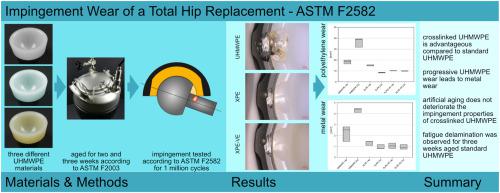Journal of the Mechanical Behavior of Biomedical Materials ( IF 3.3 ) Pub Date : 2023-11-26 , DOI: 10.1016/j.jmbbm.2023.106270 C Kaddick 1 , C Schmidt 1 , T M Grupp 2 , J Steffens 1

|
Objectives
The aim of this study was to determine the resistance to impingement damage of three different artificially aged UHMWPE materials used for total hip joint replacement. The results obtained can be used as a basis for an acceptance criterion for testing according to ASTM F2582-20.
Methods
Three different polyethylene liner materials, standard polyethylene (UHMWPE), moderately crosslinked (XLPE) and vitamin E stabilized crosslinked (XLPE-VE) polyethylene of the same design and manufacturer were tested up to one million impingement cycles according to ASTM F2582-20. The liners were artificially oxygen aged for two and three weeks according to ASTM F2003-02. The wear volumes of the liner, acetabular shells, and hip endoprosthesis stems were determined. Each of the six impingement test groups consisted of three samples. For each test group, a reference group was subjected to the same conditioning and loading conditions but without impingement between the hip stem and the liner. The force needed to disassemble the liner from the acetabular shell (push-out force) was determined according to ASTM F1820-22 for the test and the reference groups.
Results
XLPE and XLPE-VE polyethylene groups showed less impingement wear when compared to the standard UHMWPE material. Similarly, the protective function of the liner against direct metal-on-metal contact was greater, resulting in less wear on the acetabular shell and the stem neck. The three weeks aged standard UHMWPE group showed early onset of fatigue delamination wear. The push-out values remained unchanged for all XLPE liners and the 3-week aged XLPE-VE liners. The aged UHMWPE liners showed low push-out strength due to component shrinkage caused by aging in combination with the tapered fixation used for this specific design.
Significance
The largest polyethylene wear volume measured of XLPE and XLPE-VE polyethylene aged for two and three weeks was 15.05 mm³ (SD 0.56 mm³). The corresponding metal wear volume was 1.23 mm³ (SD 0.19 mm³) for the acetabular cup and 1.33 mm³ (SD 0.20 mm³) for the stem neck. Those values caition of an acceptance criteria for impingement testing. The results of the push-out test required by ASTM F2582-20 should be evaluated with respect to geometry changes caused by aging. The protective effect of the polyethylene liner against metal-on-metal contact should be considered in the implant design phase in order to avoid implant failure due to metal debris.
中文翻译:

根据 ASTM F2582 对全髋关节置换物进行冲击测试 – 植入物磨损、抗损坏性和验收标准
目标
本研究的目的是确定用于全髋关节置换术的三种不同人工老化 UHMWPE 材料的抗冲击损伤能力。获得的结果可用作根据 ASTM F2582-20 进行测试的验收标准的基础。
方法
根据 ASTM F2582-20,对三种不同的聚乙烯内衬材料,即标准聚乙烯 (UHMWPE)、中等交联 (XLPE) 和维生素 E 稳定交联 (XLPE-VE) 聚乙烯(相同设计和制造商)进行了高达一百万次冲击循环的测试。根据 ASTM F2003-02,对衬里进行了两到三周的人工氧老化。确定衬里、髋臼壳和髋关节假体柄的磨损量。六个冲击测试组中的每组由三个样品组成。对于每个测试组,参考组接受相同的调节和负载条件,但髋关节柄和衬垫之间没有碰撞。根据 ASTM F1820-22 确定测试组和参考组将内衬从髋臼壳拆卸所需的力(推出力)。
结果
与标准 UHMWPE 材料相比,XLPE 和 XLPE-VE 聚乙烯组的冲击磨损更小。同样,衬里针对金属与金属直接接触的保护功能更强,从而减少了髋臼壳和柄颈的磨损。经过三周老化的标准 UHMWPE 组显示出早期出现的疲劳分层磨损。所有 XLPE 衬里和 3 周老化的 XLPE-VE 衬里的推出值保持不变。老化的 UHMWPE 衬里表现出较低的推出强度,这是由于老化引起的部件收缩以及用于该特定设计的锥形固定。
意义
老化两周和三周的 XLPE 和 XLPE-VE 聚乙烯测得的最大聚乙烯磨损量为 15.05 mm3 (SD 0.56 mm3)。髋臼杯相应的金属磨损量为 1.23 mm3 (SD 0.19 mm3),柄颈相应的金属磨损量为 1.33 mm3 (SD 0.20 mm3)。这些值提出了冲击测试的验收标准。 ASTM F2582-20 要求的推出测试结果应根据老化引起的几何形状变化进行评估。在植入物设计阶段应考虑聚乙烯内衬对金属与金属接触的保护作用,以避免金属碎片导致植入物失效。





















































 京公网安备 11010802027423号
京公网安备 11010802027423号